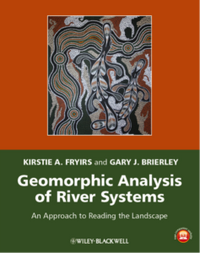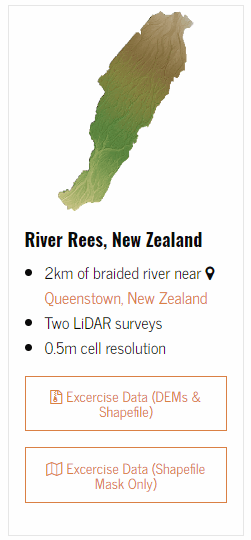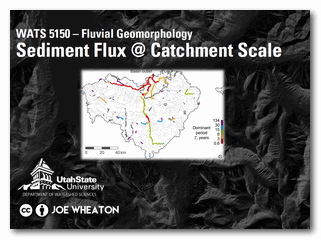Module 14: Sediment flux at the catchment scale: source-to-sink relationships
Background
In this final module we talked about sediment flux throughout a riverscape network and catchment. We used the example of sediment budgets at both the catchment-scale and reach-scale to illustrate some of the concepts of connectivity and the importance of inefency in fluvial systems.
Learning Outcomes
- Differentiate influence of external controls (e.g., climate and catchment) vs. local controls on form and process.
- Recognize the primary controls on riverscape diversity, in which distinctive suites of physical and biotic processes (behavior) help shape the form and character of those landscapes.
Lecture Slides
Slides Used in Lecture
No video
No video lecture was assigned for this module. The slides at right were used and referenced in an in-class lecture and discussion.Resources
Corresponding Chapter in Course Text
 From:
Fryirs KA, Brierley GA. 2013. Geomorphic Analysis of River Systems: An Approach to Reading the Landscape, First Edition. Blackwell Publishing Ltd.: Chichester, U.K.
From:
Fryirs KA, Brierley GA. 2013. Geomorphic Analysis of River Systems: An Approach to Reading the Landscape, First Edition. Blackwell Publishing Ltd.: Chichester, U.K.
This module focus on: CHAPTER FOURTEEN: Sediment flux at the catchment scale: source-to-sink relationships
In Class GCD Demo Exercise
 In class, we worked on the GCD Morphological Approach Exercise. We worked through the inverse method using sediment budgeting as the approach to solve for a minimum sediment flux using the example data from the River Rees at right.
In class, we worked on the GCD Morphological Approach Exercise. We worked through the inverse method using sediment budgeting as the approach to solve for a minimum sediment flux using the example data from the River Rees at right.
Relevant or Cited Literature
Follow up selected readings suggested by Fryris and Brierley (2013) are provided for every chapter in page 328-334 of the text book.
Sediment Budgeting with Morphological Approach
- Vericat D, Wheaton JM, Brasington J. 2017. Revisiting the Morphological Approach. In Gravel-Bed Rivers , . John Wiley & Sons, Ltd; 121–158.
Connectivity Index
- Cavalli M, Trevisani S, Comiti F, Marchi L. 2013. Geomorphometric assessment of spatial sediment connectivity in small Alpine catchments. Geomorphology 188 : 31–41. DOI: 10.1016/j.geomorph.2012.05.007
Sediment Routing Models
- Czuba JA, Foufoula‐Georgiou E, Gran KB, Belmont P, Wilcock PR. 2017. Interplay between spatially explicit sediment sourcing, hierarchical river-network structure, and in-channel bed material sediment transport and storage dynamics. Journal of Geophysical Research: Earth Surface 122 : 1090–1120. DOI: 10.1002/2016JF003965
- Schmitt, R. J. P., Bizzi, S., Castelletti, A., Opperman, J. J., & Kondolf, G. M. (2019). Planning dam portfolios for low sediment trapping shows limits for sustainable hydropower in the Mekong. Science Advances, 5(10), eaaw2175. DOI: 10.1126/sciadv.aaw2175
- Schmitt, R. J., Bizzi, S., Castelletti, A., & Kondolf, G. M. (2018). Improved trade-offs of hydropower and sand connectivity by strategic dam planning in the Mekong. Nature Sustainability, 1(2), 96. DOI: 10.1038/s41893-018-0022-3
- Schmitt, R. J., Bizzi, S., Castelletti, A. F., & Kondolf, G. M. (2018). Stochastic modeling of sediment connectivity for reconstructing sand fluxes and origins in the unmonitored Se Kong, Se San, and Sre Pok tributaries of the Mekong River. Journal of Geophysical Research: Earth Surface, 123(1), 2-25. DOI: 10.1002/2016JF004105
- Schmitt, R. J., Bizzi, S., & Castelletti, A. (2016). Tracking multiple sediment cascades at the river network scale identifies controls and emerging patterns of sediment connectivity. Water Resources Research, 52(5), 3941-3965. DOI: 10.1002/2015WR018097
- Tangi, M. (2018). Bilancing sediment starvation and hydropower production. The case study of the Vjosa river. Politecnico di Milano, Milan, Italy.
-
- Schmitt, R.J.P. (2016). CASCADE – A framework for modeling fluvial sediment connectivity and its application for designing low impact hydropower portfolios. Politecnico di Milano, Milan, Italy.
